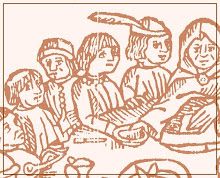The article focuses on the violence and gore in many high to late mediaeval theological images, its possible implications and the differing emphases laid on images of the perforated or violated body. The manuscript is BL Additional 37049, a Carthusian miscellany which has plenty of other creatively gruesome images. I particularly like this take on the usual memento mori: you may look pretty and rich and noble even in death, but you are still worm-food, frail mortals! Specifically, Bynum examines 20r:

British Library Additional 37049 fol. 20r. Click for full size.
Bynum cites this image to support her argument that the wounds of Christ “evoked love”. Specifically, she notes that Christ “displays his own heart … [which] bears within it all five wounds of Christ’s body, and the accompanying dialogue… ends with the hope that we will soon come to joy” (Bynum 18). She also adds that the image “returns us to the theme of fragmentation”.
However, although she quotes the exchange between Christ and the kneeling man, she doesn’t, to my mind, adequately examine the literal centrality of the heart on the page and in the poetic exchange:
Querela diuina: O man unkynde / hafe i[n] mynde / my paynes smert[.] / Beholde + see / Þat is for þe / percyd my hert [...]
Responsio humana: O lord right dere / þi wordes I here / with herte ful sore[.] / Þ[ere]fore fro synne / I hope to wynne / And greue no more [...]
The heart is the centre and focus of the page; but also, it seems to me, of their exchange. The pain in Christ’s heart is matched by the pain in the heart of man, caused by the same sin. The mutual wound suggests a shared heart – as indeed the page represents, presenting the heart as the means of communication, the addressee of the gaze and words of each. The word “heart” is exchanged between them as is the wound, something shared and mutually comprehensible. In this way, I’d question (or at least complicate) Bynum’s interpretation of the heart as Christ’s: it seems to me the heart shared between God and man. On the other hand, by that very token, it becomes a form of mediation between the human and the divine, the common halfway point: Christ himself, as the word made flesh, the mediator for humanity before God.
Aptly, the heart literalises the concept of “word made flesh”: it appears to speak. The central wound seems almost a mouth, and the words around it may be seen as issuing from it. Interestingly, though the image of Christ is made to speak, and the heart appears to, the man remains silent, except for the voice in the poem. Silent before Christ, or only capable of speaking through the emissary of the heart – whether that be addressing God through Christ, or one’s own internal voice of prayer, rather than the potentially destructive external voice?
Central throughout Bynum’s article is the idea of metonymy, “undergirded by… the doctrine of concomitance (the idea that the whole Christ is present in every particle of the eucharist)” (22):
From folk assumptions that a measure or particle (fingernails or hair) can be the person to abstruse theological debates over the mode of presence of an immaterial God, medieval culture gloried in the paradox of parts that not so much represented as were the whole. (23)
Bynum then draws the connection between this and the mediaeval obsession with numerology, particularly the ability of the right numbers to convey truth: effectively, to stand in as a metonymical “part” that might stand for / be the whole. I’d draw the comparison, for example’s sake, with the pentangle on Gawain’s shield and its ability to simultaneously represent Gawain (or the idealised version of him) and the perfection of Christ or the Trinity[1]. She applies this to the motto inscribed around the “mouth” of the heart:
Þis is þe mesure of þe wounde þ[a]t our Ih[esu]s Christ sufferd for oure rede[m]ptiou[n].
Bynum points out the emphasis on the precise length of the wound contained in “mesure”, pointing out a long mediaeval tradition in which “length is a metonym for person” (20). The correct dimensions of the wound carry with them the nature of the person represented by it, and therefore, if it adheres to those dimensions, “an image of the wound was Christ” (20). However, I’d venture to add to her conclusion. It seems to me that the evidence she cites to the effect that precise numerical detailing of an object can reproduce it in its precise identity means that perhaps in this case the numerical “mesure” need not be the central concern. If “mesure” has become abstracted to the extent she describes, we might as well read “this is the nature”, or “this is exactly that wound Christ suffered and how it was given him”. In this way the heart that is the focus of the gaze of Christ, of the kneeling man and of the reader (given the layout of the page) becomes a demonstration and revelation of the words they exchange through it: the manner of the wound, the piercing sin that harms both (or all three) in the doing, a visual representation of the exact truth – the “mesure” – of the Passion.
----------
Arthur, Ross G. Medieval sign theory in Sir Gawain and the Green Knight, Toronto: Toronto UP, 1987.
Bynum, Caroline Walker. “Violent imagery and Late Medieval Piety”, German Historical Institute Bulletin 30 (2002), 3-36. Available online on the GHI Bulletin website.


.jpg)


No comments:
Post a Comment